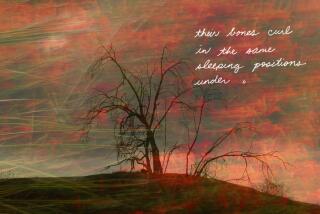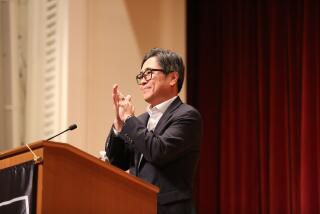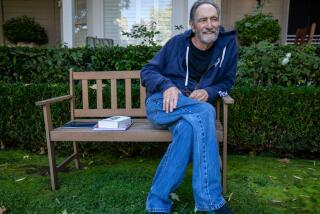The neoclassical temperament of a born rebel
At the time of his death in 1982, Kenneth Rexroth’s reputation was in decline. Honored as a mentor to the Beats and remembered as San Francisco’s leading literary intellectual, he was no longer widely read as a poet. His best-known works were translations, especially those from the Chinese and Japanese, and his cultural journalism published mainly in the Saturday Review. In the subsequent 20 years his critical standing has fallen further, despite the posthumous appearances of “Selected Poems” (1984) and “Selected Essays” (1987), both edited by Bradford Morrow, as well as a 1991 biography by Linda Hamalian. Never much noticed by academic critics, Rexroth’s verse rarely appears in the textbooks and anthologies, and he is seldom mentioned in literary scholarship. That the publication of Copper Canyon’s massive “The Complete Poems of Kenneth Rexroth” will change this situation is unlikely, but his work deserves attention, and his continuing neglect says everything about the persistent Northeastern bias that still affects discussion of West Coast literary culture.
Poet, critic, translator, anarchist and cultural impresario, Rexroth, who was born in South Bend, Ind., in 1905, occupied the intellectual center of the San Francisco Renaissance. The only child of affluent bohemian parents, Rexroth had a nourishing but unconventional childhood in a Christian Socialist household. When he was 4, his family relocated to Elkhart, the first of many moves his erratic parents made as their fortunes rose and fell. Eventually the couple separated, reuniting only briefly before his mother’s untimely death in 1916. In her final illness, Delia Rexroth refused to let her 10-year-old son attend school but read to him from her sickbed, urging him to be a writer. Three years later his alcoholic father died, and the orphaned adolescent went to Chicago to live with an aunt but quickly rebelled in the conventional new setting. After dropping out of high school at 16, Rexroth frequented bohemian Chicago, supporting himself through odd jobs and journalism. Soon he began hitchhiking across the country and later worked his way to Europe and Latin America aboard ships. In 1927, Rexroth married Andree Schafer, a painter, and the newlyweds moved to San Francisco, the city with which the poet would ever afterward be associated.
“It is the only city in the United States,” he observed, “which was not settled overland by the westward-spreading puritan tradition.” He decided to “stay and grow up in the town,” where he wrote, painted and worked in radical politics, usually just scraping by on limited funds. He briefly joined the Communist Party but left because his own principles were pacifist and anarchist. His marriage also broke up; he would eventually marry four times. Rexroth’s first collection, “In What Hour” (1940), was not published until the author was 34. Although still a strong book today, “In What Hour” received hostile reviews by New York critics who either decried his political defection from the organized Left or considered his West Coast subject matter trivial. “Regional verse that reflected the charms of the Pacific Coast,” was one verdict. Despite his growing reputation and readership, Rexroth would never be read sympathetically by Eastern critics, and he never won a major establishment award.
As “The Complete Poems” makes clear, Rexroth had written an enormous amount of apprentice work before “In What Hour.” The early poetry shows him trying nearly every modernist style -- and a few traditional ones -- before discovering his own voice, vision and versification. The poems of “In What Hour” are not always successful, but they are all recognizably Rexroth:
Autumn in California is a mild
And anonymous season, hills and valleys
Are colorless then, only the sooty green
Eucalyptus, the conifers and oaks sink deep
Into the haze; the fields are plowed, bare, waiting ....
By 1940 Rexroth’s style was already set. His cool and objective point of view, careful scene-setting, attentive natural description and conversational tone -- all inevitably conveyed in an uninflected and straightforward free verse -- reveal a surprisingly neoclassical temperament. The rhapsodic flights of his fellow Beats and the richly textured musicality of his friend Weldon Kees are almost entirely absent in Rexroth’s quiet and deliberate work. Posing neither as scholar nor poete maudit, Rexroth was the prophet and the sage. (No wonder he would prove such a capable translator of classical Chinese poetry.) “In What Hour” also shows that his subject matter was now largely fixed, and here, too, one sees the neoclassical impulse toward timeless themes. Love, nature, politics, art and mortality would become the topics of the overwhelming majority of his mature poems.
A conscientious objector and pacifist, Rexroth engaged in antiwar activity during the early days of World War II, especially by helping Japanese Americans resist internment, which made him the subject of an FBI investigation. He was eventually granted an exemption from the draft and escaped incarceration, though the strain of the situation contributed to the breakup of his second marriage. In 1944 he published “The Phoenix and the Tortoise” with New Directions, which began a lifelong partnership between him and poet James Laughlin, the greatest American publisher of Modernist literature. Now at the height of his powers, Rexroth published a steady stream of poetry, prose, translations and drama. His most notable collections of poetry include “The Signature of All Things” (1950), “The Dragon and the Unicorn” (1952) and “In Defense of the Earth” (1956). Rexroth also began translating Asian poetry in an influential series of books, most notably “One Hundred Poems From the Japanese” (1955) and “One Hundred Poems From the Chinese” (1956).
Published in an immensely productive period of only 16 years, Rexroth’s five early books still constitute the core of his poetic achievement. Written at the height of the mid-century American formalism practiced by poets such as Robert Lowell, John Berryman and Richard Wilbur, Rexroth’s work represented a distinct and innovative set of imaginative possibilities, a West Coast bohemian alternative to the standard academic style of the period. His best poems, such as “Requiem for the Spanish Dead,” “A Very Early Morning Exercise,” “For Eli Jacobson” and his elegies for his mother and first wife, which remain little known and rarely anthologized, still seem surprisingly fresh and contemporary. “Vitamins and Roughage” is a short poem from 1944 that could describe any California campus of today:
Strong ankled, sun burned, almost naked,
The daughters of California
Educate reluctant humanists;
Drive into their skulls with tennis balls
The unhappy realization
That nature is still stronger than man.
The special Hellenic privilege
Of the special intellect seeps out
At last in this irrigated soil.
Sweat of athletes and juice of lovers
Are stronger than Socrates’ hemlock;
And the games of scrupulous Euclid
Vanish in the gymnopaedia.
By 1950 Rexroth had established himself -- through hard work and sheer ambition -- at the center of San Francisco literary life. He not only published in national journals but also conducted a weekly book-review show on Berkeley’s newly established KPFA, the nation’s first listener-sponsored radio station. A public spokesman for Modernist literature, political dissent and alternative lifestyles, Rexroth became the elder statesman of San Francisco’s emerging Beat movement. The media craze surrounding the Beats turned several younger writers Rexroth had championed -- most notably Allen Ginsberg, Lawrence Ferlinghetti and Jack Kerouac -- into international celebrities, but such fame never came to Rexroth himself. He was too mature, well-read and deeply intellectual to fit the media’s definition of the Beat identity. Instead, Time magazine dubbed him, rather uncoolly, “the daddy of the Beat Generation.” And the ongoing media attention allowed Rexroth to develop with the other Beats a new form of poetry reading, not the academic lecture style still prevalent today but a performance spoken to the accompaniment of live jazz.
Rexroth’s later years were secure and comfortable. In 1968 he took a teaching position at UC Santa Barbara, which he held until his retirement in 1974. He wrote a popular literary column, “Classics Revisited,” for Saturday Review and a twice-weekly column in the San Francisco Examiner in which he was free to discuss any topic, from avant-garde art to world politics. He also toured with composer Lou Harrison’s Asian music ensemble, giving readings of his Chinese translations. In June 1982, Rexroth died at 76 in Santa Barbara where, after a Roman Catholic and Buddhist ceremony, he was buried facing the Pacific Ocean.
Although Rexroth’s poetic style may have seemed unorthodox early in his career, it prefigured the mainstream American poetry of the late 1960s. Clarity, simplicity, intelligence and intensity are the main characteristics of his style. Written in direct plain-spoken free verse, Rexroth’s poetry demonstrates an exemplary accessibility despite its evident erudition. His lines are usually end-stopped, with line breaks coming at an obvious pause of syntax or sense, a technique that heightens their conversational quality without letting them ever appear unduly chatty or verbose.
Rexroth is also a master of pictorial depiction, especially when describing the Western landscape. His images and observations demonstrate his command of precise naturalistic detail. There is a usually direct and autobiographical sense of voice in his work. In defiance of the New Critical doctrine of impersonality, the “I” in a Rexroth poem almost always purports to be the poet himself. Perhaps the “I” is partially fictionalized, but his work creates a convincing persona of the poet as speaking from his own life and situation. Rexroth’s particular gift was to craft poems that seem at once both personal and universal, as in this elegy for his first wife, who died in October 1940, simply titled, “Andree Rexroth”:
Now once more gray mottled buckeye branches
Explode their emerald stars,
And alders smoulder in a rosy smoke
Of innumerable buds.
I know that spring again is splendid
As ever, the hidden thrush
As sweetly tongued, the sun as vital --
But these are the forest trails we walked together,
These paths, ten years together.
We thought the years would last forever,
They are all gone now, the days
We thought would not come for us are here.
Bright trout poised in the current --
The raccoon’s track at the water’s edge --
A bittern booming in the distance --
Your ashes scattered on this mountain --
Moving seaward on this stream.
If “The Complete Poems” demonstrates Rexroth’s mastery over the plain-spoken modern lyric, it also documents his persistent failure to write the great long poem he so evidently longed to create. Nearly a quarter of this volume is taken up by five long poems written from 1920 to 1967. The two earliest, “The Homestead Called Damascus” (1920-1925) and “A Prolegomenon to a Theodicy” (1925-1927), amount mostly to juvenilia, ambitious modernist posturing by a young poet seeking his literary and philosophical center. The remaining three long poems, “The Phoenix and the Tortoise” (1944), “The Dragon and the Unicorn” (1952) and “The Heart’s Garden, the Garden’s Heart” (1967), show all the grace and intelligence of the mature Rexroth. These poems are well-written and well-observed but also oddly lackluster and undercharged. Whatever their charms, they feel overextended. Few modern poets have found the intellectual force and imaginative energy to sustain a long poem, and Rexroth was not one of them.
Rexroth worked to establish a West Coast identity for American poetry, one that would reflect the unique geographical, historical, cultural and ethnic qualities of the region. “I am NOT Ivy League,” he once asserted, as if anyone could have ever confused his autodidactic libertarian anarchism with Ivy League elitism or New Critical detachment. He was both a populist and an intellectual, a potent combination of cultural values in the right circumstances. Rexroth also understood that regional literary identity need not, indeed must not, be provincial. His international sense of literary enterprise led him to translate from the Chinese, Japanese, French, Spanish and Greek, all relevant sources for a California literary identity.
Rexroth’s place in the American literary canon, like that of many other California poets, such as Robinson Jeffers, William Everson, Josephine Miles, Yvor Winters, Robert Duncan and Jack Spicer, remains open to critical debate. Consistently ignored or underrated by the Eastern literary establishment, these poets continue to exercise an active influence on West Coast writers, and they continue to be read, though largely outside the academy. Amid his huge body of published work, Rexroth left a small but enduring body of original poems, elegant translations and potent essays. He may not be quite a major poet, but he remains a significant and important one, and his combined achievements as poet, critic and translator make him one of the chief American poet-critics of his age. Scholars and critics who endeavor to discuss mid-20th century American poetry responsibly ignore him at their peril.
*
Incarnation
Climbing alone all day long
In the blazing waste of spring snow,
I came down with the sunset’s edge
To the highest meadow, green
In the cold mist of waterfalls,
To a cobweb of water
Woven with innumerable
Bright flowers of wild iris;
And saw far down our fire’s smoke
Rising between the canyon walls,
A human thing in the empty mountains.
And as I stood on the stones
In the midst of whirling water,
The whirling iris perfume
Caught me in a vision of you
More real than reality:
Fire in the deep curves of your hair:
Your hips whirled in a tango,
Out and back in dim scented light;
Your cheeks snow-flushed, the zithers
Ringing, all the crowded ski lodge
Dancing and singing; your arms
White in the brown autumn water,
Swimming through the fallen leaves,
Making a fluctuant cobweb
Of light on the sycamores;
Your thigh’s exact curve, the fine gauze
Slipping through my hands, and you
Tense on the verge of abandon;
Your breasts’ very touch and smell;
The sweet secret odor of sex.
Forever the thought of you,
And the splendor of the iris,
The crinkled iris petal,
The gold hairs powdered with pollen,
And the obscure cantata
Of the tangled water, and the
Burning impassive snow peaks,
Are knotted together here.
This moment of fact and vision
Seizes immortality,
Becomes the person of this place.
The responsibility
Of love realized and beauty
Seen burns in a burning angel
Real beyond flower or stone.
-- From “The Complete Poems of Kenneth Rexroth”
More to Read
Sign up for our Book Club newsletter
Get the latest news, events and more from the Los Angeles Times Book Club, and help us get L.A. reading and talking.
You may occasionally receive promotional content from the Los Angeles Times.







